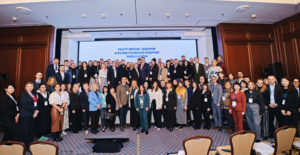Author: Abby Córdova and Natán Skigin
The following was written by Kellogg Institute Faculty Fellow Abby Córdova, associate professor of global affairs in the Keough School, and Kellogg PhD Fellow Natán Skigin, a doctoral student in the Department of Political Science. Both are research affiliates of Kellogg’s Notre Dame Violence and Transitional Justice Lab (V-TJLab).
The number of international migrants across the world has grown steadily over the last two decades, reaching 281 million in 2020. This number is only expected to grow: Russia’s invasion has already forced almost 4 million Ukrainians to flee their country. Other events, including the recent US withdrawal from Afghanistan and widespread violence in Northern Central America, suggest that many countries will continue to receive a large number of refugees.

Mexico represents one prominent example of increasing migration flows. Largely the product of US-Mexico agreements and resulting immigration policies first implemented under the Trump administration and continued during Biden’s, Mexico has become a major recipient of refugees in transit. Hundreds of thousands of migrants have been incarcerated in detention centers in Mexico as a result. According to a recent report, the number of detainees increased from 182,940 in 2019 to 307,679 in 2021, representing a 41 percent growth. Among those detained last year, 24 percent were unaccompanied children younger than 11 years of age.
Our recent fieldwork research in Mexico, funded with a Kellogg Institute’s Ford Program in Human Development Studies and Solidarity grant, revealed some of the reasons why people decide to leave their countries as well as risks they face both during their journeys and in Mexico. While in Mexico, some of the risks include state abuse and excessive use of force as well as victimization from organized criminal groups that see them as an easy prey to shore up their resources. Yet, oftentimes political elites and local media portray migrants as a threat to public security.
Our research project addresses an important and pressing research question: How can civil society organizations promote solidarity towards migrants in adverse contexts, where the state criminalizes migrants and represses them? To examine this question, we rely on qualitative and quantitative methods, including in-depth interviews and survey experiments. The quantitative part of our research is also supported with an external grant from Evidence in Governance and Politics (EGAP)and internal funding from Notre Dame Research.
Our first trip to Mexico to conduct research on our project involved visits to Mexico City and Tapachula (Chiapas) in the southern border. Locals refer to Tapachula as the “prison city,” because it houses the largest immigration detention center in Latin America and thousands of undocumented migrants are stranded there, unable to cross city borders and continue their trip north without facing a high risk of detention and deportation. In Tapachula, we encountered thousands of migrants from Haiti, Africa, Cuba, Venezuela, Colombia, El Salvador, Honduras, Guatemala, and Nicaragua living in tents in public squares, in overcrowded rented spaces, or in civil society-run migrant shelters. During the course of ten days in Mexico City and Tapachula, we conducted over 50 in-depth interviews with migrants and advocates of migrants’ human rights, including shelters’ directors.
Our fieldwork in Mexico was a transformative, life-changing experience. We encountered widespread despair, difficult to describe in words, but also incredible manifestations of resilience and solidarity. To voice the experiences of migrants who wanted their stories to be known, in this article we share some excerpts of their testimonies, protecting their identities.

Violence at Home, Violence Abroad
Migrants find themselves forced to leave their country for multiple reasons. In Mexico, the migrants we interviewed were mainly fleeing economic hardship, political repression, and enduring violence. For example, many Central American migrants shared with us that they left because they were facing constant harassment from gangs or other organized criminal groups trying to force them or their family to pay a criminal tax (“renta” or “derecho de piso”). No longer being able to pay, migration became the only option in a context of widespread police corruption. Migrants’ testimonies attest the dangers they are fleeing:
“They shot me here [shows the scars on his body]…. We never were involved in drug trafficking, but the people who killed my grandfather also wanted to hurt me. Over there, there are no thieves, no gangs, the narco governs, law enforcement does not do anything, the law can be bought…a person who is captured by the police can pay and then be let free and even get his gun back. Over there, it is pure corruption. Before I made the decision to leave, they were following me, but I escaped. After that, I said, this isn’t life, I better leave.”
The dangers migrants encounter during their journey are also enormous. The migrants we interviewed coming from South America, mainly Haitians, Colombians, and Venezuelans had crossed the dangerous Darién Gap – the jungle between Colombia and Panama. Most of them indicated that criminal groups assaulted them in the jungle, and that they had seen dead bodies along the way, including children. They showed us videos of the terrifying scenes they had encountered. “This was the most difficult part of my journey to Mexico. I saw people die while climbing a mountain in the jungle,” a Haitian woman who left Brazil told us. It took her almost a month to arrive in Mexico.
Once in Mexico, migrants face additional challenges. Since they cannot leave the city borders without the threat of detention and deportation, most migrants arriving in Tapachula apply for asylum or humanitarian visas in Mexico. If they are lucky to have their application processed, they can leave the city. However, the National Immigration Institute (INM) takes months to process migrants’ applications, leaving thousands of migrants in limbo and living in the most precarious conditions. In fact, the INM stopped processing applications completely after a massive migrant protest last month.
Having one’s documents processed, however, does not preclude detention. We heard repeatedly that oftentimes the joint military-police force, the Guardia Nacional, detains migrants in the streets after arbitrarily destroying their Mexican documents, which they were able to obtain only after waiting a long time or, as many also mentioned, after paying a bribe. We saw migrants transported in cars with bars, called “perreras” or “dog cages,” after being detained in raids. The excessive use of force against migrants has been widely documented, captured in videos and posted in social media. Migrants shared with us their experiences with the police. One of them described how the Guardia Nacional repressed the caravan he had joined, which left him with a broken leg:
“That confrontation was so violent. It was the riot police. Many were injured…there were about 150 riot police and we tried a way to dialogue with them so the rest of our group could continue their journey, but there was no way. This is what happens when one is looking to have a better life. You do not know what’s going to happen to you.”
Despite mounting evidence of human rights abuses, over 50 percent of Mexicans agree that the government should use the Guardia Nacional to combat undocumented migration. Our research seeks to examine how to generate attitudinal and behavioral change conducive to more favorable views and conduct towards migrants rooted in solidarity and respect for human rights and the rule of law. Prejudice against migrants in Mexico is largely driven by racist attitudes and the criminalization of migrants. Because many of them do not have a place to sleep or eat, they are accused of making the city look dirty, and negative attitudes are even stronger towards Black migrants. Even though a high proportion of them are escaping political and criminal violence, locals often call them criminals.

Solidarity Among and Toward Migrants
During enduring times, when food, clothes, and other resources are scarce, many would expect little solidarity among migrants. “It’s every person for himself or herself,” some would anticipate. But research shows cooperation often flourishes in hard, desperate times. We also found widespread solidarity among migrants in Mexico. For example, a Nigerian migrant recounted how people help each other in the most difficult situations as they were crossing the Darien jungle:
“We saw dead bodies. We also encounter people starving who would die. We took food from our bags and gave it to them. We had to assist each other. I ended up without food for myself, only water from the river.”
The testimony of another Guatemalan migrant fleeing sexual violence, who had been previously deported from Mexico, also exemplifies migrants’ mutual help:
“When I was in the detention center and was deported, the authorities did not care that many of us did not have any money to go back to Guatemala City and left us in another town in the middle of the night. A woman with a good heart I did not know, who had also been in the detention center and deported, rented a room for all of us. She provided for us. Without her support, I do not know what we would have done.”
Despite their different nationalities, migrants cooperate with each other both along the way as well as once in Mexico: they share food and information, help body-disabled populations do their paperwork, and even protest together relying on sophisticated networks, whereby they gather in massive numbers to advocate for their rights. Solidarity and cooperation foster individual and collective agency.
This solidarity likely emerges because of a shared identity: the migrant identity. Humans can construct identities out of almost anything: shared race, gender, nationality, and religion, but also shared experiences. In Mexico, migrants from different countries across continents have a lot of similarities because of their common stories and, often, the same opponents: migration authorities, state security forces, and criminal groups.

Despite their limited resources, civil society organizations also aid migrants in multiple ways, increasing access to medical and psychological attention, providing shelter and legal assistance, running programs to help migrants find a source of income, and promoting activities to counteract discrimination and prejudice against them. As an advocate of migrants’ human rights explained, political elites’ rhetoric has contributed to the criminalization of migrants in Mexico and consequently to reproduce negative attitudes towards them among the local population:
“With this government, there has been a setback. For years, we had been lobbying to treat migration as a humanitarian crisis. But now the government treats it as a national security issue and that changes everything.”
Migrant shelters and other non-governmental organizations seek to bring about empathy and solidarity towards migrants among the local population through different mechanisms, including artistic expressions, as illustrated by the beautiful murals depicted in the photos we share in this article. They also devise media campaigns and multiple activities to foster better relationships between host communities and migrants.
While solidarity among and towards migrants from civil society organizations is remarkable, we also witnessed that solidarity across nationalities can be eroded when state authorities attempt to break migrants’ unity. We saw how public officials prioritized some nationalities over others and grouped them according to some unspecified criteria. Latinos in one row, Haitians and Africans in another. Immigration officials promise to release some nationalities’ paperwork sooner than the others, creating divisions between them out of beliefs that some were favored over others. By highlighting their differences along skin color and nationalities, arbitrary state actions jeopardize inter-migrant solidarity without solving individuals’ migration situation.




